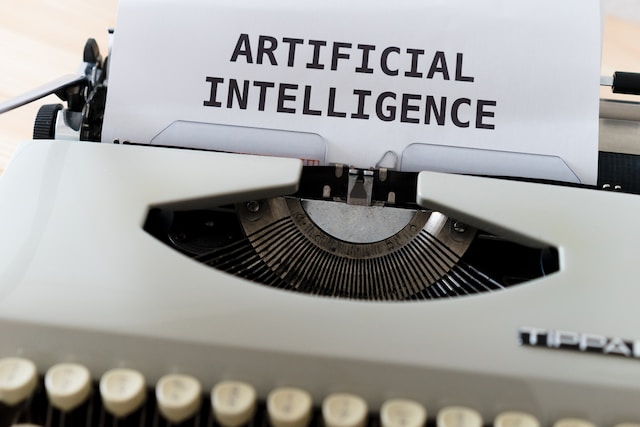Generative AI Revolution: Blurring Creativity Boundaries
In the realm of cutting-edge technological advancements, Artificial Intelligence (AI) has unquestionably emerged as a frontrunner, achieving remarkable milestones. Within this vast domain, one area that has captured considerable attention is Generative AI. This captivating subset of AI is solely focused on the art of crafting and synthesizing original content, spanning across various mediums such as images, music, text, and even engaging in lifelike, human-like conversations. The extraordinary capabilities of Generative AI have left us astounded, witnessing the creation of content that often bears an uncanny resemblance to human craftsmanship. It’s truly fascinating to witness the Generative AI revolution, blurring the lines between human and machine creativity. Artificial Intelligence (AI) has made significant strides in recent years, with one of the most captivating areas being Generative AI. This subset of AI is dedicated to creating and synthesizing fresh content, including images, music, text, and lifelike human-like conversations. Generative AI holds tremendous promise for revolutionizing diverse industries, such as entertainment, art, healthcare, and business. In this essay, we will delve into the foundations, practical applications, and future implications of Generative AI.There was a review from HARVARD BUSINESS thatAI can not only boost our analytic and decision-making abilities but also heighten creativityGenerative AI, or GenAI, has truly revolutionized the landscape of Artificial Intelligence, showcasing its remarkable capability to create a myriad of captivating data types. From stunning images, mesmerizing videos, and delightful audio to engaging text and intricate 3D models, GenAI can craft them all with uncanny finesse. While the concept of Generative AI dates back to the 1960s, it was the advent of generative adversarial networks (GANs) in 2014 that truly sparked a creative revolution. These machine learning algorithms unleashed the power of GenAI, enabling it to produce incredibly lifelike visuals, videos, and sounds that rival the work of human artisans. GenAI achieves this by immersing itself in vast troves of data, analyzing and understanding the underlying patterns and nuances that make each piece unique. With this knowledge, GenAI ventures into uncharted creative territories, concocting masterpieces that showcase an artistic flair akin to human brilliance. It’s awe-inspiring to witness how Generative AI blurs the lines between artificial intelligence and genuine human creativity, leaving us captivated by its astounding output. The core principle behind Generative AI is the ability to learn patterns from existing data and utilize that knowledge to generate entirely new and unique outputs. By analyzing vast amounts of data, GenAI algorithms can understand the underlying structures and characteristics present in the dataset. Leveraging this understanding, GenAI can then create highly convincing and complex content that exhibits human-like creativity.Generative AI historyThe Eliza chatbot created by Joseph Weizenbaum in the 1960s was one of the earliest examples of generative AI. These early implementations used a rules-based approach that broke easily due to a limited vocabulary, lack of context, and overreliance on patterns, among other shortcomings. Early chatbots were also difficult to customize and extend. The field saw a resurgence in the wake of advances in neural networks and deep learning in 2010 that enabled the technology to automatically learn to parse existing text, classify image elements, and transcribe audio. Ian Goodfellow introduced GANs in 2014. This deep learning technique provided a novel approach for organizing competing neural networks to generate and then rate content variations. These could generate realistic people, voices, music, and text. This inspired interest in — and fear of — how generative AI could be used to create realistic deep fakes that impersonate voices and people in videos. Since then, progress in other neural network techniques and architectures has helped expand generative AI capabilities. Techniques include VAEs, long short-term memory, transformers, diffusion models, and neural radiance fields.Understanding Generative AI:Generative AI delves into the fascinating realm of training machines to grasp patterns and unleash their creative prowess by generating fresh and captivating content. This extraordinary feat is accomplished through the employment of cutting-edge deep learning models like Generative Adversarial Networks (GANs), Variational Autoencoders (VAEs), and Recurrent Neural Networks (RNNs). These powerful models enable machines to delve into the very essence of a dataset, comprehending its underlying patterns with remarkable acuity. Armed with this knowledge, the machines embark on an awe-inspiring journey of creation, conjuring forth novel outputs that bear a striking resemblance to the original data they were trained on. It’s truly remarkable to witness how Generative AI empowers machines to mimic and even transcend human-like creativity, opening up a world of endless possibilities.The working model of GAN is shown belowHow does a GAN WorkGANs have three main components:Generative: The goal of the generative component is to learn a model that can generate new samples that resemble the training data. This is accomplished by capturing the probability distribution of the data. For example, for generating images, the generative model learns to produce new images that appear similar to the training set.Adversarial: The training process in GANs is framed as a game between two components: the generator and the discriminator. The adversarial component involves training these two models simultaneously in an adversarial setting. The generator aims to generate samples that can deceive the discriminator, while the discriminator aims to accurately distinguish between real and fake samples.Networks: GANs utilize deep neural networks as the underlying architecture for both the generator and the discriminator. Neural networks can learn complex patterns and representations from data. In GANs, these networks are trained using backpropagation and gradient descent to improve their performance.In the GAN framework, the generator generates synthetic samples, such as images or audio, while the discriminator’s role is to distinguish between real and fake samples. The generators and discriminators compete against each other during the training phase, with the goal of improving their abilities. The generator aims to generate samples that are indistinguishable from real data, while the discriminator classifies the samples as real or fake.Generator Model The Generator is trained while the Discriminator is idle. After the Discriminator is trained by the generated fake data of the Generator, we can get its predictions and use the results for training the Generator and get better from the previous state to try and fool the Discriminator.Discriminator Model The Discriminator is trained while the Generator is idle. In this phase, the network is only forward propagated and no back-propagation is done. The Discriminator is trained on real data for n epochs and sees if it can correctly predict them as real. Also, in this phase, the Discriminator is also trained about the fake generated data from the Generator and sees if it can correctly predict them as fake.How does generative AI work?Generative AI, at its core, operates by utilizing a prompt — whether in the form of text, image, video, design, or musical notes — and leveraging various AI algorithms to generate new content in response. This content can range from essays and problem solutions to remarkably realistic creations derived from images or audio of individuals.In the early stages of generative AI, the process of submitting data involved complex procedures, often requiring the use of APIs or specialized tools. Developers had to familiarize themselves with programming languages like Python and write applications accordingly. However, recent advancements in the field have led to improved user experiences and simplified workflows. Innovators in generative AI are actively working on enhancing the usability of users. These developments allow individuals to describe their requests in plain language, eliminating the need for extensive technical knowledge. After an initial response, users can further customize the generated results by providing feedback on the desired style, tone, and other specific elements they wish the content to reflect. This user-centric approach aims to make generative AI more accessible and intuitive, empowering a broader range of individuals to leverage its capabilities effectively.It is worth noting that while generative AI has simplified the user experience, ensuring its ethical and responsible use remains paramount. Clear guidelines and standards should be established to address concerns surrounding data privacy, authenticity, and potential misuse of generated content.This is the workflow model for generative AI:The power of Generative AIGenerative AI has emerged as a strong breakthrough, in reshaping the way we communicate, work, and innovate. Its impact can be seen through the widespread adoption and rapid growth of platforms like ChatGPT, which boasts an impressive user base of 100 million individuals. This popularity speaks volumes about the transformative potential of generative AI, as well as its stable diffusion and strong presence on platforms like GitHub.Even in its dormant stages, generative AI has already made significant strides in shaping various domains and industries. Its influence is too strong to expand exponentially in the coming years, opening up a world of unimaginable possibilities. By embracing this powerful technology, we can unlock a new era of boundless creativity, enhanced efficiency, and remarkable progress.Let’s delve deeper into some of the fascinating applications that generative AI has to offer.:TEXT GENERATION: Text generation is a fascinating area within machine learning that involves the creation of new text based on patterns and structures learned from existing text data. It leverages various models such as Markov Chains, Recurrent Neural Networks (RNNs), and more recently, Transformers, which have significantly advanced the field of text generation by offering extended attention capabilities. Markov Chains are probabilistic models that generate text by predicting the next word based on the current word or sequence of words. While they can produce coherent text, their limitations lie in their inability to capture long-range dependencies and context. RNNs, on the other hand, are particularly effective in capturing sequential patterns in text data. These models process input text word by word, maintaining an internal memory that retains information from previous words. This allows RNNs to generate text that exhibits more context and coherence. However, RNNs can struggle with long-range dependencies and tend to produce repetitive or generic text.ExampleThe above question was asked by me to ChatGPT on brief info about what is HazelnutIMAGE GENERATION: Image generation is a captivating field in deep learning that explores the fascinating realm of creating new images that closely resemble real-world visuals. This innovative process relies on sophisticated algorithms like Variational Autoencoders (VAEs), Generative Adversarial Networks (GANs), and the more recent Stable Diffusion models. These algorithms possess the incredible ability to learn intricate patterns and structures from existing image data and utilize that knowledge to generate visually stunning and unique images. VAEs, for instance, operate as generative models that learn a condensed representation of input images known as the latent space. This latent space becomes the foundation for generating new images. By sampling different points from the latent space, VAEs can produce an extensive range of plausible and captivating images, enabling a diverse spectrum of image generation possibilities. On the other hand, GANs comprise two neural networks: a generator and a discriminator. The generator strives to produce images that are indistinguishable from real images, while the discriminator’s role is to assess and differentiate between generated and real images. Through an adversarial training process, GANs continuously refine their ability to generate images that possess striking visual similarities to real-world counterparts. More recently, Stable Diffusion has emerged as an exciting technique in image generation. This method involves a progressive iterative process that refines a generated image over time. By deliberately introducing and removing noise in a controlled manner, Stable Diffusion models generate high-quality images that exhibit realism and attention to detail. These advancements in image generation demonstrate the remarkable capabilities of deep learning algorithms. By harnessing the power of VAEs, GANs, and Stable Diffusion models, we are unlocking new possibilities for creative expression and visual exploration in the realm of computer-generated imagery.VIDEO AND SPEECH GENERATION: Video generation is a captivating application of deep learning methods, notably Generative Adversarial Networks (GANs) and Video Diffusion, that focuses on generating new videos by predicting frames based on previous frames. By leveraging the temporal dependencies and patterns present in video data, these models can generate realistic and visually coherent video sequences. Generative Adversarial Networks (GANs) have been extended to video generation, where a generator network predicts future frames given a sequence of previous frames. The generator aims to produce frames that are visually similar to the real video frames, while a discriminator network assesses the authenticity of the generated frames. Through an adversarial training process, GANs enhance their ability to generate compelling and high-quality videos. Video Diffusion is another technique used for video generation. It involves iteratively refining the generated frames over time by gradually adding and removing noise, resulting in visually pleasing and coherent video sequences. Video generation has a wide range of applications across different fields. In the entertainment industry, it can be used for special effects, virtual reality experiences, and generating synthetic content for movies and games. In sports analysis, video generation enables the creation of realistic simulations and visualizations for coaching, training, and performance analysis. Additionally, in the field of autonomous driving, video-generation techniques can be employed to generate synthetic training data for training autonomous vehicles.DATA AUGUMENTATION: Data augmentation is a process of generating new training data by applying various image transformations such as flipping, cropping, rotating, and color jittering. The goal is to increase the diversity of training data and avoid overfitting, which can lead to better performance of machine learning models.The Application of Human-Computer Interaction:Auxiliary Automatic Driving: Santana et al.[36] implemented assisted autonomous driving with GAN. First, an image is generated, that is consistent with the distribution of the official traffic scene image, and then a transition model is trained based on the cyclic neural network to predict the next traffic sceneText to Image: This field is the result of a collision between NLP (Natural Language Processing) and CV (Computer Vision). The task is described as generating a picture that matches the image text from a given textual description. StarkGAN generates high-resolution images from text descriptions. The model decomposes the generation process into two more controllable steps: to draw the basic shape and color of the object; to correct the shortcomings of the first stage results and add more detail. Extensive experiments are performed to prove that the method is more effective. By introducing an attentional generative network, AttnGAN can synthesize fine-grained details of different sub-regions of an image by focusing on the related words in natural language description. In addition, a deep attentional multimodal similarity model is proposed to calculate the fine-grained image-text matching loss for generator training. It is the first time that the layered attentional GAN can automatically select word-level conditions to generate different parts of the image. In addition, some researchers expect to use GAN learning methods in the fields of pharmaceutical molecules and materials science to generate pharmaceutical molecular structures and synthetic new material formulations. The idea is quite creative, if it can be realized in reality, and the artificial Intelligence will be omnipotentWhat are Dall-E, ChatGPT, and Bard?Dall-E, ChatGPT, and Bard are prominent examples of generative AI interfaces that have gained popularity in recent years. Dall-E is a multimodal AI application that connects the meaning of words to visual elements by training on a large dataset of images and their associated text descriptions. It utilizes OpenAI’s GPT implementation and allows users to generate imagery in multiple styles based on user prompts. Dall-E 2, a more advanced version, was released in 2022, offering enhanced capabilities and style-driven image generation. The potential applications of Dall-E include the following:Advertising: Advertisers can use DALL-E to create realistic images of the products they want to sell. This will significantly reduce business costs, as photography and editing requirements will be drastically reduced.Entertainment: DALL-E could completely reshape the entertainment industry, whether that be movies, TV shows, or video games. The developers of media franchises could use DALL-E to conceptualize characters, levels, backgrounds, or any other element of the design process — removing the need to pay for experts in that area.Art: DALL-E’s outputs could theoretically create a whole new area of the art world — AI artwork. This would likely provide countless ways that users could monetize the created artwork.Schools: Teachers could use DALL-E to provide visual aids to boost their students’ learning capabilities. This could be particularly useful if the teacher isn’t skilled in drawing/painting yet still wishes to use these visual aids in the classroom.ChatGPT, powered by OpenAI’s GPT-3.5 implementation, is an AI-powered chatbot that gained widespread attention when it was introduced in November 2022. Unlike earlier versions of GPT, ChatGPT allows interactive feedback and fine-tuning of text responses through a chat interface. It simulates real conversations by incorporating the history of its interaction with users. Following its popularity, Microsoft made a significant investment in OpenAI and integrated a version of GPT into its Bing search engine. People have used ChatGPT to do the following:* Code computer programs.* Compose music.* Draft emails.* Summarize articles, podcasts, or presentations.* Script social media posts.* Create a title for an article.* Solve math problems.* Discover keywords for search engine optimization.* Create articles, blog posts, and quizzes for websites.* Reword existing content for a different medium, such as a presentation transcript for a blog post.* Formulate product descriptions.* Play games.* Assist with job searches, including writing resumes and cover letters.* Ask trivia questions.* Describe complex topics more simply.Bard, developed by Google, is a chatbot built on a lightweight version of its LaMDA family of large language models. While Google had previously open-sourced some of its transformer AI models, Bard marked its entry into the public-facing chatbot space. Its initial release was rushed in response to Microsoft’s integration of GPT into Bing. However, Bard faced criticism after inaccurately claiming that the Webb telescope was the first to discover a planet in a foreign solar system, leading to a decline in Google’s stock price. Google subsequently introduced a new version of Bard, built on PaLM 2, its advanced large language model. This updated version offers improved efficiency and visual response capabilities.These generative AI interfaces demonstrate the progress and challenges in the field of natural language processing and multimodal AI. While they have encountered some initial setbacks in terms of inaccuracies and erratic behavior, ongoing advancements and refinements continue to shape their capabilities, making them valuable tools for various applications. A few of the applications include:* Content Generation* Creative Writing* Marketing and Advertising* EducationUse CasesImplementing chatbots for customer service and technical support.Deploying deepfakes for mimicking people or even specific individuals.Improving dubbing for movies and educational content in different languages.Writing email responses, dating profiles, resumes, and term papers.Creating photorealistic art in a particular style.Improving product demonstration videos.Suggesting new drug compounds to test.Designing physical products and buildings.Optimizing new chip designs.Writing music in a specific style or tone.Applications of Generative AI in Natural Language ProcessingText Generation: Generative AI models, such as GPT-3, can be used for text generation tasks. These models can generate human-like text based on a given prompt or context. They have been used in various applications like generating creative stories, writing poetry, and even composing music.Machine Translation: Generative AI models have shown promising results in machine translation tasks. By training on large bilingual corpora, these models can learn to generate high-quality translations between different languages. They have improved the accuracy and fluency of machine translation systems significantly.Chatbots and Virtual Assistants: Generative AI models have been employed in the creation of conversational agents, chatbots, and virtual assistants. These models can understand user queries and generate relevant responses, making them useful for customer support, information retrieval, and personal assistants.Text Summarization: Generative AI can be used to automatically generate summaries of long documents or articles. By understanding the main points and key information, these models can generate concise and coherent summaries that capture the essence of the text. This application has proven useful in areas like news aggregation and document summarization.Dialogue Systems: Generative AI models can be used in building interactive dialogue systems. These systems can engage in natural language conversations, understanding user inputs and generating appropriate responses. Dialogue systems find applications in various domains, including customer service, virtual agents, and language tutoring.Content Generation: Content Generation: Generative AI models can be used for generating content for various purposes, such as marketing, social media, and content creation. These models can generate relevant content to meet specific topics or target audiences, saving time and effort in content creation.Sentiment Analysis and Opinion Mining: Generative AI models can be trained to understand and analyze the sentiment and emotions expressed in text. This can be useful in applications such as social media monitoring, customer feedback analysis, and brand reputation management.Personalization and Recommendation Systems: Generative AI models can be employed in building personalized recommendation systems. By understanding user preferences and past behavior, these models can generate personalized recommendations for products, services, articles, and more.Impact of Generative AI on JobsGenerative AI will have a potential impact on us in the following ways:Job Automation: Generative AI technologies can perform tasks that were performed by humans. This could lead to job replacement in industries where AI systems can perform tasks more efficiently, quickly, and cost-effectively. Jobs such as data entry, content generation, or image editing, may be particularly affected. Generative AI-powered robots can perform tasks in hazardous environments that are unsafe or challenging for humans. By utilizing these robots, humans can be spared from engaging in dangerous situations.Job Transformation: While some jobs may be automated, generative AI can also lead to job transformation. It can replicate human capabilities by automating mundane tasks, allowing workers to focus on higher-level, creative, or complex tasks. For example, AI tools can assist graphic designers in generating initial designs, which they can then refine and customize.Changes in Job Hours: The coming of generative AI can lead to changes in job hours. As automation will improve efficiency, it may reduce the time required to complete tasks. This will result in shorter working hours, increased productivity, or the ability to handle more work within the same timeframe.Home and Leisure Applications: Generative AI can have a significant impact on how it is used at home or for leisure. For instance, it can be employed in various creative pursuits such as generating music, artwork, or writing. People can use AI tools to generate ideas, improve their creative output, or explore new possibilities. Additionally, generative AI can be used in gaming to create more immersive and dynamic experiences.Personalized Recommendations: Generative AI algorithms excel at analyzing vast amounts of data to offer personalized recommendations tailored to individual preferences. This technology finds its applications in diverse domains, ranging from entertainment and shopping to travel. AI systems leverage user preferences, behavior, and historical data to suggest options that align with their unique tastes and preferences. By understanding user needs and patterns, Generative AI algorithms provide highly tailored and relevant recommendations, enhancing the overall user experience and facilitating informed decision-making. Whether it’s suggesting movies, products, or travel destinations, Generative AI empowers individuals with personalized choices that resonate with their specific interests and desires.Ethical Considerations: Issues such as data privacy, algorithmic bias, and the impact on employment need to be addressed immediately. Society must carefully navigate the benefits and potential risks associated with the widespread adoption of generative AI technologies.BenefitsAutomating the manual process of writing content.Reducing the effort of responding to emails.Improving the response to specific technical queries.Creating realistic representations of people.Summarizing complex information into a coherent narrative.Simplifying the process of creating content in a particular style.LimitationsLack of transparency: Generative AI and ChatGPT models are unpredictable, and not even the companies behind them always understand everything about how they work.Accuracy: Generative AI systems sometimes produce inaccurate and fabricated answers. Assess all outputs for accuracy, appropriateness, and actual usefulness before relying on or publicly distributing information.Bias: You need policies or controls in place to detect biased outputs and deal with them in a manner consistent with company policy and any relevant legal requirements.Intellectual property (IP) and copyright: There are currently no verifiable data governance and protection assurances regarding confidential enterprise information. Users should assume that any data or queries they enter into the ChatGPT and its competitors will become public information, and we advise enterprises to put in place controls to avoid inadvertently exposing IP.Cybersecurity and fraud: Enterprises must prepare for malicious actors’ use of generative AI systems for cyber and fraud attacks, such as those that use deep fakes for social engineering of personnel, and ensure mitigating controls are put in place. Confer with your cyber-insurance provider to verify the degree to which your existing policy covers AI-related breaches.Sustainability: Generative AI uses significant amounts of electricity. Choose vendors that reduce power consumption and leverage high-quality renewable energy to mitigate the impact on your sustainability goals.ConcernsIt can provide inaccurate and misleading information.It is more difficult to trust without knowing the source and provenance of information.It can promote new kinds of plagiarism that ignore the rights of content creators and artists of original content.It might disrupt existing business models built around search engine optimization and advertising.It makes it easier to generate fake news.It makes it easier to claim that real photographic evidence of wrongdoing was just an AI-generated fake.It could impersonate people for more effective social engineering cyber attacks.Examples of Generative AI toolsText generation tools include GPT, Jasper, AI-Writer, and Lex.Image generation tools include Dall-E 2, Midjourney, and Stable Diffusion.Music generation tools include Amper, Dadabots, and MuseNet.Code generation tools include CodeStarter, Codex, GitHub Copilot, and Tabnine.Voice synthesis tools include Descript, Listnr, and Podcast.ai.AI chip design tool companies include Synopsys, Cadence, Google, and Nvidia.The Future of Generative AIGenerative AI will have a profound impact on content creators across various industries, necessitating a shift in their roles and skills. Jobs involving text, images, hardware designs, music, video, and more will be significantly altered. Workers will need to transition from content creation to content editing, requiring a different skill set to work effectively alongside generative AI systems.The workforce’s interaction with applications will also undergo a transformation as applications become more conversational, proactive, and interactive, leading to a redesigned user experience. In the near future, generative AI models will move beyond merely responding to natural language queries and start suggesting unexpected options. For instance, when requesting a data-driven bar chart, the model might offer alternative graphics it deems suitable. While this has the potential to enhance worker productivity, it challenges the conventional notion of humans as the sole drivers of strategy development.The overall impact on the workforce will vary significantly based on factors such as industry, location, enterprise size, and offerings. The extent of change brought about by generative AI will differ across these contexts.The capabilities demonstrated by ChatGPT highlight the tremendous promise of generative AI for widespread adoption. However, they have also shed light on the challenges of deploying this technology in a safe and responsible manner. Nevertheless, these early implementation difficulties have spurred research into improved tools for detecting AI-generated text, images, and video. Industry and society will collaborate to develop better mechanisms for tracking information provenance, fostering trust in AI systems. Additionally, advancements in AI development platforms will accelerate research and development efforts, leading to enhanced generative AI capabilities in various domains, including text, images, video, 3D content, drugs, supply chains, logistics, and business processes. The integration of these capabilities into existing tools will drive significant changes in how we work. Grammar checkers, design tools, and training platforms will seamlessly incorporate more useful recommendations into workflows, enabling efficient knowledge sharing and productivity gains. These examples represent just a fraction of the transformative impact that generative AI will have on our work processes. The incredible depth and ease of ChatGPT have shown tremendous promise for the widespread adoption of generative AI. To be sure, it has also demonstrated some of the difficulties in rolling out this technology safely and responsibly. But these early implementation issues have inspired research into better tools for detecting AI-generated text, images, and video. Industry and society will also build better tools for tracking the provenance of information to create more trustworthy AI. Furthermore, improvements in AI development platforms will help accelerate research and development of better generative AI capabilities in the future for text, images, video, 3D content, drugs, supply chains, logistics, and business processes. As good as these new one-off tools are, the most significant impact of generative AI will come from embedding these capabilities directly into versions of the tools we already use. Grammar checkers are going to get better. Design tools will seamlessly embed more useful recommendations directly into workflows. Training tools will be able to automatically identify best practices in one part of the organization to help train others more efficiently. And these are just a fraction of the ways generative AI will change how we work.Which industries are most impacted by generative AI?Generative AI is poised to have a transformative impact on various industries, including pharmaceuticals, manufacturing, media, architecture, interior design, engineering, automotive, aerospace, defense, medical, electronics, and energy. It will augment core processes and revolutionize supporting functions across organizations. Here are some examples of how generative AI will shape these industries:In the pharmaceutical sector, we anticipate that by 2025, over 30% of new drugs and materials will be systematically discovered using generative AI techniques. This marks a significant shift from the current scenario where such techniques are rarely employed. The application of generative AI in drug discovery holds immense potential to enhance efficiency, reduce costs, and accelerate the development of new treatments.Marketing strategies will also experience a significant impact as generative AI becomes more prevalent. We predict that by 2025, around 30% of outbound marketing messages from large organizations will be synthetically generated, a substantial increase from the less than 2% observed in 2022. AI-powered text generators like GPT-3 can already generate compelling marketing copy and personalized advertising, offering companies new avenues for engaging with their target audiences.The manufacturing, automotive, aerospace, and defense industries stand to benefit from generative design capabilities. By leveraging generative AI, engineers can create optimized designs that align with specific goals and constraints, including performance metrics, material considerations, and manufacturing methods. This approach accelerates the design process by generating a range of potential solutions for exploration and evaluation.ConclusionThe remarkable capability of ChatGPT, Bard, and other generative AI systems to generate text that closely resembles human writing has captured the curiosity, interest, and excitement of many. In the immediate future, efforts will be directed toward improving the user experience and workflows with generative AI tools. This involves refining the interfaces and interactions to ensure seamless integration and usability. Additionally, establishing trust in the results generated by these systems is crucial. Transparency, explainability, and accountability will be key factors in building trust and confidence in the outputs produced by generative AI.The ethical concerns, such as biasing, wrong information, and misuse, will also be a priority. Striking the right balance between creativity and responsibility is essential in the development and deployment of generative AI systems. Many companies will leverage generative AI to customize and improve their branding and communication strategies by utilizing their own data. Programming teams will use generative AI to enforce company-specific best practices for writing and formatting code, resulting in more readable and consistent programming practices. Vendors will integrate generative AI capabilities into their existing tools, streamlining content generation workflows and driving innovation to boost productivity. Generative AI can also find applications in data processing, transformation, labeling, and vetting as part of augmented analytics workflows. Semantic web applications can benefit from generative AI to automatically map internal taxonomies of job skills to external taxonomies used on skills training and recruitment platforms. Business teams can leverage generative AI models to transform and label third-party data for more advanced risk assessments and opportunity analysis.Looking ahead, generative AI models will likely be expanded to support a wide range of domains, including 3D modeling, product design, drug development, digital twins, supply chains, and business processes. This expansion will facilitate the generation of new product ideas, experimentation with different organizational models, and exploration of diverse business opportunities. The possibilities for generative AI’s future applications are vast, promising exciting developments in various industries and sectors.
Learn More >







